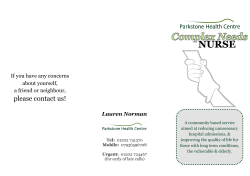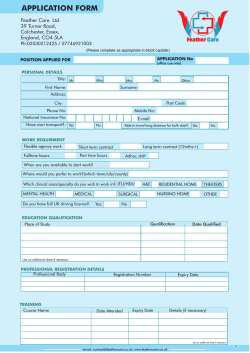
VULNERABILITY AND THE INSTITUTION OF MARRIAGE
FINEMAN GALLEYSPROOFS2 5/27/2015 2:16 PM VULNERABILITY AND THE INSTITUTION OF MARRIAGE THE EVOLUTION OF PLURAL PARENTAGE: AFTERWORD Martha Albertson Fineman* Since 2007, the Vulnerability and the Human Condition Initiative at Emory has been developing the concepts of vulnerability and resilience and the idea of the “vulnerable subject” as the only appropriate legal subject around which to build law and policy. In the place of an idealized construct based on autonomy, independence, and self-sufficiency—our present liberal legal subject—the vulnerability paradigm recognizes that every actual adult human being, no matter how strong and independent he or she may seem, is both presently and has been in the past reliant on others and on social institutions. The idea of a universal “vulnerable subject” to replace the universal liberal subject thus raises new issues, poses different questions, and opens up new avenues for critical and theoretical exploration. Within this emerging body of scholarly inquiry, Stu Marvel’s Article1 addresses polygamy, same-sex marriage, and plural parentage by examining the legal response to multiple vulnerable subjects, primarily and most significantly children and the institution of marriage or the marital family. Children are the paradigmatic vulnerable subjects, exemplifying how human vulnerability can be realized in the form of dependency on others. However, vulnerability, unlike dependency, is a constant and universal aspect of the human condition, located in our embodiment and susceptibility to harm. While the vulnerability of children is typically conceded, at least in a simplified form or when confused with dependency, the idea that vulnerability is inherent in the human condition is often resisted. While analyzing societal institutions as vulnerable subjects is even less common, it deserves serious theoretical attention. As a vulnerability analysis reveals, one significant way that the state responds to the embodied vulnerability of individuals and the needs this generates is through the creation of societal institutions and relationships of responsibility and rights. * Robert W. Woodruff Professor of Law, Emory University School of Law; Founding Director, Vulnerability and Human Condition Initiative, Emory University. 1 Stu Marvel, The Evolution of Plural Parentage: Applying Vulnerability Theory to Polygamy and Same-Sex Marriage, 64 EMORY L.J. 2047 (2015). FINEMAN GALLEYSPROOFS2 2090 5/27/2015 2:16 PM EMORY LAW JOURNAL [Vol. 64:2089 Historically, the marital family has been considered the ideally appropriate societal arrangement to provide for its members’ needs, particularly in supplying the essential material, physical, financial, and relational resources necessary for healthy growth and development of children. In her Article, Stu Marvel analyzes how this mode of state response to embodied human vulnerability through the marital family has paved the way for same-sex couples’ claim to marriage equality. She also argues that it also might bolster future claims to access the institution for even less traditional intimate childrearing entities, such as polygamous or plural partner families. She asks specifically: will the definition of marriage and legal family expand to accommodate any entities caring for vulnerable and dependent children? Vulnerability theory provides particularly useful insights into questions concerning the definition of marriage and the function of the marital family. It is not based on a claim of rights but on an understanding of the allocation of the state of societal responsibility for both universal developmental needs and the periodic and inevitable dependency shared by all human beings. On this individual level, the vulnerable subject stands as a challenge to the now-dominant image of the liberal legal subject, which is cast as a fully functioning, autonomous adult. In contrast to the liberal subject’s demand for liberty and a restrained state, the vulnerable subject is primarily concerned with the state’s role in responding to universal and constant human vulnerability by ensuring individuals develop “resilience.” Unlike the static liberal legal subject, the vulnerable subject is understood as a changing subject, embodying different needs and abilities, and often dependent upon others at various stages of normal development. While levels of dependency may change over the life course, there is no position of invulnerability at any stage. Rather, individuals have different degrees of resilience, which are found in the accumulation of resources that mediate, compensate, or alleviate our vulnerability to harm and injury as embodied beings. Unlike vulnerability, which is basic to the human condition, resilience is produced within society. We are not born resilient; it is produced over time and within state-created institutions and in social, political, and economic relationships. The fact that these institutions and relationships are founded in and regulated by law is the basis for the claim that we need a responsive, not a restrained, state. Because vulnerable individuals are inextricably embedded in FINEMAN GALLEYSPROOFS2 2015] THE EVOLUTION OF PLURAL PARENTAGE: AFTERWORD 5/27/2015 2:16 PM 2091 these institutional structures and relationships throughout life, they should be a central focus of political and legal theory. A vulnerability approach disrupts the mantra of “personal responsibility, autonomy, and self-sufficiency” so prevalent in current neoliberal discourse and so often directed at certain designated and stigmatized “vulnerable populations.” As embodied and embedded beings, we are all constantly and universally vulnerable to forces beyond individual control. And, as human creations, institutions are also vulnerable and in need of state response if they are to remain resilient in the face of change. Stu Marvel’s Article thus encourages us to think through current debates around same-sex marriage and polygamous marriage in a new way, not by applying the lens of individual rights and antidiscrimination discourse but by tracking the ways in which the vulnerabilities of the state, social institutions, and human embodiment intersect in ways not visible from the rights-bearing position of the liberal legal subject.
© Copyright 2025










